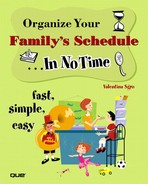Leading the Way for the Rest of the Family
You can't realistically expect the planner system you worked so hard to select and set up to work if you're sabotaging its cooperative nature by not using it yourself. How long do you expect your children to check the schedule when they're making plans if you aren't keeping your part of the schedule up-to-date? How long before your older children stop entering their plans into your family's planner if you never bother to check it before making plans that turn out to conflict with the information they've taken the time to post? If the system is going to work, everyone must share in its use with the same level of commitment. As an adult, you are responsible for setting the standard.
It's also your responsibility to establish and implement a vision for your family's collective life. So, while your teenager might set a long-term goal of getting a summer job, you must plan more broadly for major changes such as buying a new car or maybe even a new house. And now that you have your family's day-to-day schedule honed, you should feel confident in your ability to apply the same organizing skills to planning such an event. The techniques we discussed back in Chapter 3, “Creating an Activity Schedule,” for creating an activity map, to do list, and timeline and then scheduling the steps into your family's planner work equally well for large projects as they do for less complicated activities.
note
 | The Bound to Be Or ganized Sidetracked Home Executives Planner is a hard-copy planner designed specifically to help someone who's primarily in charge of running a family household to manage the family's schedule and maintain balance. Suggested retail: $99.95. Website: www.shesintouch.com |
Don't forget to select an individual planning tool—hard copy or electronic—that fits your needs and style.
Perhaps you're still conflicted on your choice of a personal organizer because you prefer to take notes with a pad and pen, but you also feel you need to manipulate your information electronically. Even this sort of quandary isn't a valid excuse in today's world! Some currently available products combine input that appeals to a kinesthetic and visual learner with output that has the flexibility of digital technology. For example, you can get a ballpoint pen that writes on specially encoded paper so that when you then place the pen in a dock attached to your computer, it will transfer information exactly as you wrote or drew it. When you select different check boxes on the paper, the information automatically will be entered into your electronic address book, calendar, email, or wherever else is appropriate.
note
 | The Logitech io2 Digital Writing System, shown in Figure 11.1, writes like a regular ballpoint pen on specially formulated paper from Mead, Post-It, and Franklin Covey, and then transfers your writing through a dock to your Windows-based computer. It's compatible with software programs such as Microsoft Outlook and Lotus Notes. Suggested retail: $199.99. Website: www.logitech.com Figure 11.1. This ballpoint pen and digital paper system records everything you write both on paper and electronically at the same time.
|



